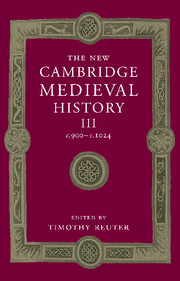Book contents
- Frontmatter
- 1 Introduction: reading the tenth century
- PART I GENERAL THEMES
- PART II POST-CAROLINGIAN EUROPE
- PART III NON-CAROLINGIAN EUROPE
- 19 European Russia, c. 500–c. 1050
- 20 Bohemia and Poland: two examples of successful western Slavonic state-formation
- 21 Hungary
- 22 Byzantium in equilibrium, 886–944
- 23 Bulgaria: the other Balkan ‘empire’
- 24 Byzantium expanding, 944–1025
- 25 Byzantium and the West
- 26 Southern Italy in the tenth century
- 27 Sicily and al-Andalus under Muslim rule
- 28 The Spanish kingdoms
- Appendix genealogical tables
- List of primary sources
- Bibliography of secondary works arranged by chapter
- Index
- Frontispiece
- Plate section
- Map 2: Archbishoprics and bishoprics in the early eleventh century
- Map 4: Germany
- Map 13: Byzantium in 1025
- References
27 - Sicily and al-Andalus under Muslim rule
from PART III - NON-CAROLINGIAN EUROPE
Published online by Cambridge University Press: 28 March 2008
- Frontmatter
- 1 Introduction: reading the tenth century
- PART I GENERAL THEMES
- PART II POST-CAROLINGIAN EUROPE
- PART III NON-CAROLINGIAN EUROPE
- 19 European Russia, c. 500–c. 1050
- 20 Bohemia and Poland: two examples of successful western Slavonic state-formation
- 21 Hungary
- 22 Byzantium in equilibrium, 886–944
- 23 Bulgaria: the other Balkan ‘empire’
- 24 Byzantium expanding, 944–1025
- 25 Byzantium and the West
- 26 Southern Italy in the tenth century
- 27 Sicily and al-Andalus under Muslim rule
- 28 The Spanish kingdoms
- Appendix genealogical tables
- List of primary sources
- Bibliography of secondary works arranged by chapter
- Index
- Frontispiece
- Plate section
- Map 2: Archbishoprics and bishoprics in the early eleventh century
- Map 4: Germany
- Map 13: Byzantium in 1025
- References
Summary
by the beginning of the tenth century Muslim expansion had come to an end in most areas of the Mediterranean world. On the south-eastern frontiers of the Byzantine empire the border was firmly established in the Anti-Taurus mountains, leaving the Muslims in control of the plains, the Byzantines of the uplands. The weakened ′Abbāsid caliphate was no longer in a position to mount major expeditions using the resources of the entire Islamic near east as it had a century before. Malatya, the Cilician plain and Antioch still remained in Muslim hands but they would be lost to Islam in the next century.
The eastern Mediterranean saw the gradual resurgence of Byzantine seapower. Until 905 the Tulunid rulers of Egypt had controlled most of the eastern coast and had maintained a fleet in Tarsus, but the ′Abbasid reconquest of Egypt in that year seems to have put an end to this. In 969 the Fatimids moved east from Tunisia to Egypt and attempted to regain the initiative at sea, but by this time Tarsus and the other northern ports had been lost and the Fatimids were forced to make do with Tripoli and Acre, much further to the south. The loss of Crete to the Byzantines in 961 marked another important step in this process.
In the western Mediterranean, Sicily, the Balearic Islands and much of the Iberian peninsula remained firmly in Muslim hands. It was in these areas that the Muslims were able to set up strong and effective states and the tenth century was in many ways the golden age of al-Andalus. Even in these areas, however, expansion had virtually ceased. Raids were still made on Christian communities in Italy and Spain, but the age of conquest was over, and the age of bureaucracy had arrived.
Keywords
- Type
- Chapter
- Information
- The New Cambridge Medieval History , pp. 646 - 669Publisher: Cambridge University PressPrint publication year: 2000



